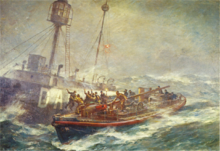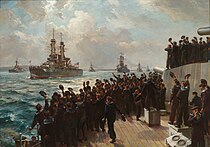Bernard Finegan Gribble | |
|---|---|
 Gribble in 1921 | |
| Born | Bernard Emmanuel Finegan Gribble 10 May 1872 |
| Died | 21 February 1962 (aged 89) Poole, Dorset |
| Occupation(s) | Artist, painter, illustrator |
| Spouse | Eleanor Mabel ('Nellie') Clunn |
Bernard Finegan Gribble (10 May 1872 – 21 February 1962) was a prolific British artist and illustrator who specialised in marine subjects. Although he also painted portraits and landscapes, much of Gribble's artistic production was concerned with the drama and excitement of ships and sailors on the high seas or at port, whether as historical tableaux or representing contemporary events and subjects.
Biography
[edit]Bernard Finegan Gribble was born at South Kensington, London on 10 May 1872, the youngest of two children of Herbert Augustine Keate Gribble and Julia Mary (née Finagan).[1] His father was an architect (known for his design of the Brompton Oratory and the Armada Memorial at Plymouth).[2][3] Bernard was educated at the College of St. Francis Xavier in Bruges, Belgium. He briefly studied under his father and then studied drawing at the South Kensington Art School (one of his tutors being Albert Toft).[1][4]
In 1891, Gribble's painting The Burning of the 'Mentmore' was accepted for exhibition at the Royal Academy.[1]
During 1898, Bernard was employed as an artist-correspondent to The Queen and Black and White, covering both the Spanish-American War and the Fashoda Incident.[1][5]
In 1902, Bernard Gribble and Eleanor Mabel Clunn (known as 'Nellie') were married at Kensington. The couple had no children.[1]
Although his work included landscapes and portraits, Gribble was best known as a painter of historical (and often romanticised) maritime scenes. Spanish galleons and treasure vessels are well represented in his work, and one critic described him as a "specialist in burning ships". Others compared his paintings to the fine marine vistas of the late 19th-century seascape artist, Henry Moore, acknowledging Gribble's skill in the accurate portrayal of costume and technical detail and his ability to convey an authentic period atmosphere.[6][7][3]

In his preparatory sketches of ships, Gribble made notes on the precise structure and names of sails, masts, and rigging. He had studied the movement of water closely, and made highly technical analyses of the construction of rigging and sails to a level where it naturally informed his naval subjects. He also paid close attention to the detail of costume. The evident quality of Gribble's marine pictures lies in the artist's mastery of the oil painting medium adapted to a profound understanding of his chosen subject.[8]
Gribble's paintings were exhibited at prestigious institutions and his paintings were widely sought after. He exhibited regularly at the Royal Academy in the period 1898 to 1904 and at the Paris Salon from 1905 (receiving an honourable mention in 1907).[2][5][1] He also exhibited at the Royal Institute of Oil Painters and the Royal Glasgow Institute of the Fine Arts.[4] In 1912 Gribble was appointed as marine artist to the Worshipful Company of Shipwrights.[8]
Gribble also worked as an illustrator, his work appearing in many leading magazines including The Illustrated London News and The Graphic.[1] He provided the illustrations for the last of Arthur Conan Doyle's pirate stories, 'The Blighting of Sharkey', which was published in Pearson's Magazine in April 1911.[6][9] Gribble also illustrated several books and his work was published on royal postcards, menus and chocolate boxes.[1][10]
Gribble was the first official artist to be appointed during World War I. Because of his existing reputation as a marine artist much of his work was with the Royal Navy.[11] Gribble was present at the scuttling of the defeated German fleet in June 1919 at Scapa Flow in the Orkney Islands. He witnessed the events on board the trawler Sochisin and produced two large oil paintings from the experience. The Sinking of the German Fleet at Scapa Flow captures the scene when German sailors from the cruiser Frankfurt approached the trawler in a lifeboat, but were ordered at gunpoint to return to their ship to stop it sinking.[12][13][14]
Owners of paintings by Bernard Gribble included the United States president Franklin D. Roosevelt. He purchased a painting showing the arrival of American destroyers at Queenstown in Ireland during World War I. It hung in the Oval Office of the White House when Roosevelt became president in 1933.[1] The President reputedly suggested the painting's name – The Return of the Mayflower – to the artist. Roosevelt also purchased Surrender of the German Fleet to the Grand Fleet at Scapa Flow.[15] Other notable purchasers of Gribble paintings included Queen Mary, the German Kaiser (before the war), and Jackie Onassis.[1][11] The Kaiser was so impressed by Gribble's work that King George V summoned the artist to a royal residence to meet him.
By the 1920s, Gribble left London to live in Dorset.[2] Bernard and Nellie Gribble settled at Poole in county Dorset, living at 3 Springfield Crescent, Parkstone. The Poole and East Dorset Art Society was founded in 1924, with Gribble as its first chairman.[16] Other members of the society included Henry Lamb and Augustus John.[17]
In December 1941, a stamp featuring Gribble's painting Grenfell on the Strathcona was issued by Newfoundland, commemorating the 150th anniversary of the founding of Wilfred Grenfell's medical mission to the colony.[18]
Bernard Gribble died on 21 February 1962 at 60 Alexandra Road, Poole, aged 89.[1] He was buried in the Parkstone cemetery in Poole. After her husband's death Nellie Gribble donated many of his works to Poole Museum, which now possesses the world's largest collection of his paintings. The collection numbers 250 paintings, drawings, prints and photographs. Typical paintings in the Poole collection are The Plague Ship, The Whelp of the Black Rover and The Return of the Argosy Galleons, but there are also some local topographical works such as depictions of the Guildhall, the Custom House, views of the Quay and harbour, a portrait of former Mayor of Poole, Herbert Carter, in civic regalia, and one of a woman believed to be Gribble's wife Nellie.[6]
Nellie Gribble died on 8 September 1963 and was buried with her husband at Parkstone cemetery.[1]
Gallery
[edit]-
Morgan's Prize (1901), oil on canvas, Poole Museum.
-
HMNSZ New Zealand with the Cruiser Squadron under Admiral of the Fleet, Lord Beatty, at early action of Battle of Jutland, 1916, watercolour.
-
The Arrival of the American Fleet Off Scapa Flow, December 1917 (1920), oil on canvas.
-
HMS Bedouin, oil on canvas, National Maritime Museum.
-
Canadian Pacific poster (c. 1926), lithography print by Eyre & Spottiswoodt Ltd., London.
Official purchases
[edit]- Sinking of German Fleet, Scapa Flow 1918 (7 ft canvas) -- Preston Art Gallery and Museum
- The Doomed Fleet -- Bristol Museum and Art Gallery
- The Captain's Last Landing -- Plymouth City Museum and Art Gallery
- No Surrender from the Pirate Captain—Plymouth City Museum and Art Gallery
- Departure of the Pilgrim Fathers—Plymouth City Museum and Art Gallery
- Market St, Poole -- Russell-Cotes Art Gallery & Museum, Bournemouth
- Bournemouth, Our Golden Argosies (canvas)—Presented by D Elliot Alves esq to the Federal Parliament House, Australia
- Surrender of the German Fleet 1918, United States Naval Academy, Annapolis
- The Mayflower's Return, United States Naval War College, Rhode Island
- Two similar subjects to the above, President Roosevelt for the White House
- The Duchess of York Receiving the Freedom of the Worshipful Company of Shipwrights (4), National Maritime Museum, Greenwich
References
[edit]- ^ a b c d e f g h i j k l Gribble, Bernard, Suffolk Artists website; accessed 21 July 2024.
- ^ a b c Robert Wall (1998), Ocean Liner Postcards in Marine Art 1900-1945, Woodbridge, Suffolk: Antique Collector's Club, page 146.
- ^ a b Bernard Finegan Gribble (1873-1962), Mark Mitchell: Paintings & Drawings website; accessed 21 July 2024.
- ^ a b David Buckman (1998), Dictionary of Artists in Britain Since 1945, Bristol: Art Dictionaries, page 512.
- ^ a b Notable Londoners, an Illustrated Who's Who of Professional and Business Men (1922), London: London Publishing Agency, page 15; accessed 20 July 2024.
- ^ a b c Wessex in 100 Objects - Bernard Gribble, Art UK website; accessed 21 July 2024.
- ^ The Plague Ship by Bernard Gribble, Wessex Museums website; accessed 21 July 2024.
- ^ a b Peter Davies (1987), page 60.
- ^ 'The Blighting of Sharkey', Pearson's Magazine, April 1911, Vol. 31, pages 353-362.
- ^ Royal "Greetings" for Commoners, The Illustrated London News, 19 November 1910, page 796; The firm of Raphael Tuck..., The Illustrated London News, 3 December 1927, page 1038.
- ^ a b John Fairley (2018), The Armistice and the Aftermath, Pen & Sword Books.
- ^ David Meara (2019), The Great Scuttle: The End of the German High Seas Fleet, Amberley Publishing.
- ^ The Orcadian Book of the 20th Century: A Chronicle of Our Times (2000), Kirkwall: Orcadian Ltd., page 79.
- ^ 'The Scuttling at Scapa', The Times, 25 June 1919, page 13.
- ^ 'Paintings fit for a President', Dorset Echo (Weymouth), 20 January 2001.
- ^ Peter Davies (1987), page 69.
- ^ Peter Davies (1987), page 50.
- ^ Steve Forgo (1979), Paintings and Graphic Arts on the Stamps of Great Britain and the Nations of the British Commonwealth, Montreal: Phil-Art Distribution Reg'd, page 221.
- Sources
- Peter Davies (1987), Art in Poole and Dorset, Poole: Poole Historical Trust (ISBN: 978-0-9504914-6-2).
Sources and external links
[edit]- 62 artworks by or after B. F. Gribble at the Art UK site
- The Paintings of Bernard Finnigan Gribble [dead link]
- Roger Guttridge (2001), 'No-one could paint the sea as well', Dorset Life, October 2001.
- Who's Who in Art, The Art Trade Press, Ltd., 1962, 10th Edition.
- Who Was Who 1961–1970. A & C Black. 1979. ISBN 0-7136-2008-0.




